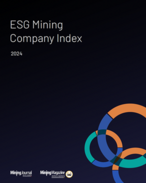This article is 12 years old. Images might not display.
At BHP, 15% of the short-term incentives of executives are based on a balanced scorecard of environment, social and governance (ESG) measures. Long-term incentives, however, are based on total shareholder returns, with no explicit ESG metrics.
At Stockland, it is typically between 10-20%. National Australia Bank (NAB) "sets the level of target [short-term] incentive so that it provides a meaningful proportion of the executive’s total remuneration",.
Boards globally have started exploring different ways for integrating ESG factors in incentive mechanisms for senior management, notes the report, 'Integrating ESG issues into executive pay'. However, "while emerging practices are taking shape, there is no universally agreed guidance on how to link ESG metrics to executive pay".
BHP Billiton has long used safety as a key metric – predominantly injury frequency rates – but last year it adopted a balanced scorecard approach for its ESG metrics, including fatalities, significant environmental incidents, HSE risk management, human rights impact assessment and environment and occupational health.
Each year the sustainability committee of the board receives a detailed paper on the company's Health, Safety, Environment and Community performance and then advises the remuneration committee of its assessment.
"A focus on the growing relationship between these two committees has been a key part of BHP Billiton’s evolution in improving its governance and its metrics setting processes," says the case study.
But the report also notes there is no 'one size fits all' approach to integrating ESG factors in remuneration policies, recommending companies determine their own metrics according to their sector and individual circumstances.
NAB's corporate responsibility scorecard currently includes customer satisfaction and customer complaints, growth of microfinance loans, diversity, staff turnover, staff engagement, carbon emissions and supply chain contracts that meet its sustainability principles.
Both NAB and Stockland engage their stakeholders to help determine the criteria. The property group surveys customers, engages governments, receives feedback from clients and reviews media activity to determine the "materiality" of criteria. It also brings in its risk and strategy leaders to ensure the metrics align with corporate strategy.
The Stockland balanced scorecard comprises four key categories, with financial and business-related performance holding the most weight. The other factors relate to stakeholders and customers, people and leadership, and sustainability, health and safety.
Every employee is given four to six objectives from each of the balanced scorecard’s categories, with a minimum weighting of 5% for the ESG-related metrics.
However, it recently shifted away from a formulaic weighting of each factor as it over-prioritised financially related metrics. Individual assessment is now based on an overall performance assessment.
"For example, if an executive has an objective that is tied to health and safety in the workplace, and a serious incident occurred, it would previously only account for 10% of the bonus. However, under the company’s new scheme, the bonus would be cancelled out because of the overall performance assessment."
Indeed the report recommends incentive compensation should be subject to such "downward discretionary adjustments" to account for unusual events or unintended consequences.
"By applying modifying mechanisms to executive compensation, boards can ensure that executives are properly incentivised to take precautions and mitigate potential risks."
This article courtesy of BEN-Global























